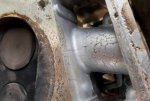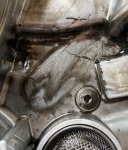And for the third time they are shrinkage fins
If you run your finger over them they are raised up off the surface not sunken down into the surface .
When the castings come out of the mould they have a tough skin on the outside but are still partially molten inside
As the last bits solidify it causes the whole casting to contract and those fins are the result from it getting smaller as it cools from 800 C to room temperature.
Bigger flatter ones are defects in the mould surface that have been polished out and strait ones are join lines because some of these moulds are better than 20 little bits clamped together .
It is all about driving down the cost price for the customer .
They could use moulds & a casting cycle that ends up producing smooth surfaced castings but that takes about 5 times longer per casting and halves the service life of the moulds so just about quadruples the cost of each casting.
Way back when people would pay a proper price they polished off all of these but again that takes a long time & pushes up the price .
Ask a plastic surgeon , pretty is not cheap .


